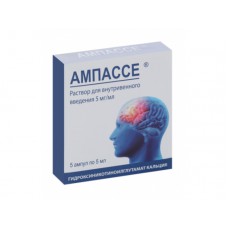Expiration date: 11/2027
Dosage form
A clear, colorless or yellowish-tinged solution.
Composition
COMPOSITION (per 1 ml):
active ingredient - Ampasse (calcium hydroxynicotinoyl glutamate) - 5 mg;
auxiliary substance - water for injection - up to 1 ml.
Pharmacotherapeutic group
other psychostimulants and nootropic drugs
Pharmacodynamics
The neurochemical mechanism of action of the drug is mediated by interaction with the glutamatergic system at the level of modulation of AMPA receptors.
The results of the phase III clinical trial (Ampasse-III-02) convincingly prove the effectiveness of Ampasse in patients with chronic cerebrovascular accident due to arterial hypertension and (or) atherosclerosis of the main arteries of the head. The effectiveness of the treatment was assessed by its effect on cognitive functions of the brain (an increase in the MoHS score by 2 points or more, compared with the group of patients taking placebo on the 30th day after the start of therapy). The proportion of patients for whom treatment was considered successful on the MoHS scale on the 30th day after the start of therapy in the Ampasse group and the placebo group was 83.87% and 22.58%, respectively. Thus, the effectiveness of treatment in the Ampasse group was 61.29% higher than in the control group (95% CI: 45.087 - 72.478%; p<0.001).
Prolonged administration of the drug does not lead to accumulation of the effect, the development of tolerance or the appearance of adverse reactions. Withdrawal of the drug after prolonged administration does not cause withdrawal syndrome.
The drug is low-toxic
Pharmacokinetics
When studying the pharmacokinetics of Ampasse during phase I and II clinical trials (intravenous and intramuscular administration), it was found that the values of the main pharmacokinetic parameters of hydroxynicotinoylglutamate with intravenous administration are characterized by high interindividual variability. The variability of pharmacokinetic parameters during intramuscular administration was small. The pharmacokinetic processes in the studied group of patients in the dose range of 10-50 mg with intravenous administration were nonlinear. The bioavailability of hydroxynicotinoyl glutamate when administered intramuscularly to healthy volunteers was 1-3% of the intravenous dose.
Based on data obtained during clinical trials, the half-life in humans is about 4 hours. The main route of drug elimination is renal excretion
Indications
Chronic cerebrovascular accident
Contraindications
Hypersensitivity to the components of the drug, pregnancy, breast-feeding, age under 18 years, impaired renal function, impaired liver function
USE DURING PREGNANCY AND LACTATION
It is contraindicated to use the drug during pregnancy and during breastfeeding. If necessary, breastfeeding should be discontinued during lactation. In animal studies, no effects on reproductive function, as well as embryotoxic and teratogenic effects were found.
Method of administration and dosage
The drug is administered intravenously in a slow jet at a dose of 25 mg (5 ml) once a day for 15 days
Side effects
According to the results of the safety assessment of the phase III clinical trial, it was noted that dizziness (0.8% of cases) and mild drowsiness (0.8% of cases) are possible in rare cases during intravenous administration of the drug. There were no clinically significant deviations from the norm in the results of vital signs assessment and laboratory blood and urine tests. In rare cases, allergic reactions to individual components of the drug may occur. No such reactions have been reported in clinical trials.
However, if any undesirable side effects occur, it is necessary to stop using the drug and consult a doctor.
If you notice any other side effects not listed in the instructions, tell your doctor.
Overdose
No cases of overdose have been reported
Drug interaction
The drug reduces the toxic effects of ethyl alcohol
Special instructions
EFFECTS ON THE ABILITY TO DRIVE VEHICLES AND WORK WITH MECHANISMS
The drug should not be used for these types of activities, as there is no data on the study of the drug's effect on the ability to drive vehicles and work with mechanisms.
Storage temperature
from 2℃ to 25℃
Special storage conditions
Do not freeze


